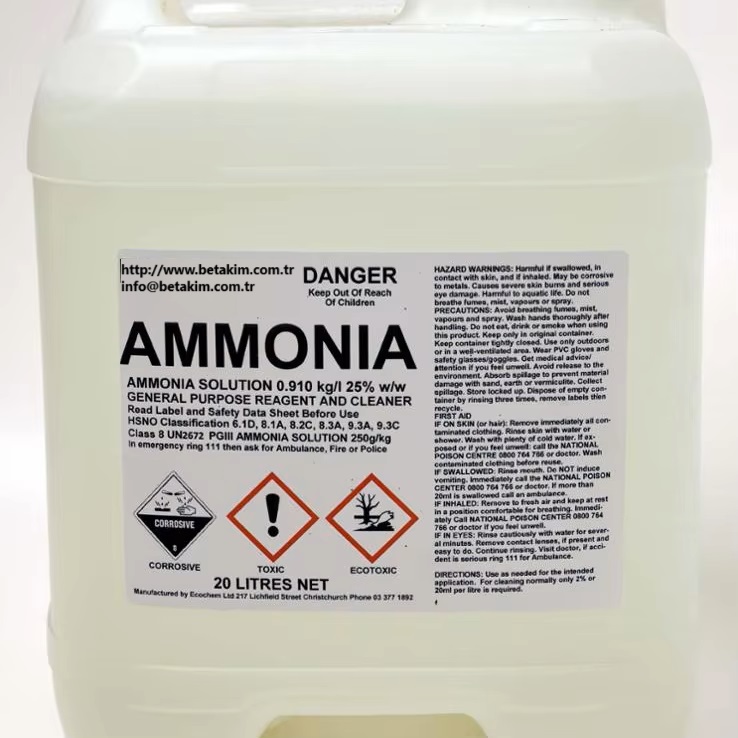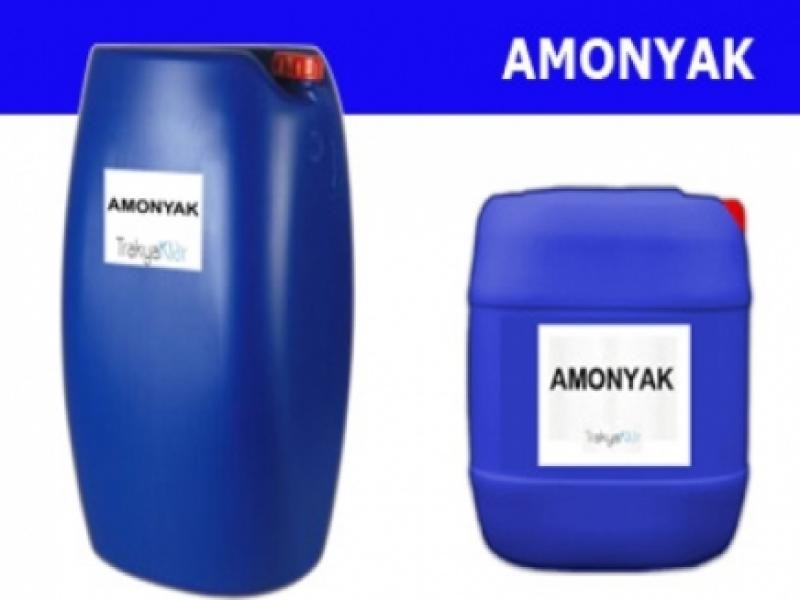We unleash your business potential by maximize the business innovation.
Send EmailAmmonia, Am-fol, 7664-41-7
CAS: 7664-41-7
Molecular Formula: H3N
Names and Identifiers
Physico-chemical Properties
| Molecular Formula | H3N |
| Molar Mass | 17.03 |
| Density | 1.023g/mLat 25°C |
| Melting Point | −78°C(lit.) |
| Boling Point | 60°C |
| Flash Point | 52°F |
| Water Solubility | soluble |
| Solubility | Miscible with ethanol (95%) and water. |
| Vapor Presure | 8.75 atm ( 21 °C) |
| Vapor Density | 0.6 (vs air) |
| Appearance | Liquid |
| Color | Colorless |
| Odor | Intense pungent odor detectable at 17 ppm |
| Exposure Limit | TLV-TWA 25 ppm (~18 mg/m3) (ACGIHand MSHA), 50 ppm (OSHA); STEL35 ppm; IDLH 500 ppm (NIOSH). |
| Merck | 14,492 |
| BRN | 3587154 |
| pKa | 38(at 25℃) |
| Storage Condition | 0-6°C |
| Stability | Stable. Hygroscopic. Flammable. Incompatible with acids, strong oxidizing agents. May react violently with acids, aldehydes, alkylene oxides, amides, boron, boron halides, calcium, chlorine azide |
| Sensitive | Hygroscopic |
| Explosive Limit | 25% |
| Physical and Chemical Properties | Colorless gas. There is a strong irritating odor. |
| Use | Used in chemical, food, pharmaceutical and other industries |
Risk and Safety
| Risk Codes | R11 - Highly Flammable R20 - Harmful by inhalation R36/37/38 - Irritating to eyes, respiratory system and skin. R67 - Vapors may cause drowsiness and dizziness R39/23/24/25 - R23/24/25 - Toxic by inhalation, in contact with skin and if swallowed. R10 - Flammable R50 - Very Toxic to aquatic organisms R34 - Causes burns R23 - Toxic by inhalation R36 - Irritating to the eyes R66 - Repeated exposure may cause skin dryness or cracking R40 - Limited evidence of a carcinogenic effect R36/37 - Irritating to eyes and respiratory system. R19 - May form explosive peroxides |
| Safety Description | S26 - In case of contact with eyes, rinse immediately with plenty of water and seek medical advice. S7 - Keep container tightly closed. S45 - In case of accident or if you feel unwell, seek medical advice immediately (show the label whenever possible.) S36/37/39 - Wear suitable protective clothing, gloves and eye/face protection. S16 - Keep away from sources of ignition. S9 - Keep container in a well-ventilated place. S61 - Avoid release to the environment. Refer to special instructions / safety data sheets. S36/37 - Wear suitable protective clothing and gloves. |
| UN IDs | UN1005 |
| WGK Germany | 2 |
| RTECS | BO0875000 |
| TSCA | Yes |
| HS Code | 28141000 |
| Hazard Class | 3 |
| Packing Group | II |
| Toxicity | LD50 oral (rat) 350 mg/kg LC50 inhal (rat) 2000 ppm (4 h) PEL (OSHA) 35 ppm (27 mg/m3) TLV-TWA (ACGIH) 25 ppm (17 mg/m3) STEL (ACGIH) 35 ppm (27 mg/m3) |
Upstream Downstream Industry
| Raw Materials | Nitrogen Ammonia Coke(coal) Phosphoric acid Phosphoric acid Hydrogen Ammonia |
| Downstream Products | Ammonium Bisulfite 2,4-Dinitroaniline |
Nature
colorless gas, with a strong pungent odor, easy to be liquefied into a colorless liquid. Relative density 0. 77 (liquid), melting point -77.7 ℃, boiling point -33.5 ℃, vapor pressure (25.7 ℃)1013kPa, explosion limit (volume fraction) is26 ~ 28% (in air),13.5% ~ 79% (in oxygen),2.226 ~ 72% (in N2 0), self ignition point 651. Pressure at room temperature can be liquefied, the critical temperature of 132.4 ℃, the critical pressure of 11366. 7kPa. Soluble in water, ethanol, ether and organic solvents. High temperature decomposition into ammonia and hydrogen, there is a reduction. It can be oxidized to carbon monoxide in the presence of a catalyst.
Preparation Method
The main raw materials are coal (or Coke, natural gas, etc.), air and water. The process of industrial production of ammonia is generally divided into gas, desulfurization conversion, compression refining and synthesis process.
Standard
This product contains ammonia (NH3) should be 25.0% ~ 28.0% (g/g).
Trait
- This product is a colorless clear liquid; Strong irritating special odor; Volatile; Alkaline reaction.
- This product can be mixed with water or ethanol.
relative density
The relative density of this product (General 0601) is 0. 900~908.
Use
boiler feed water pH regulator, ammonia is used to neutralize the carbonic acid in the feed water, increase the pH value, and slow down the corrosion of carbon dioxide in the feed water. It is also a boiler shutdown protection agent, a small amount of water in the boiler can not release the boiler also has a better protection effect.
Differential diagnosis
take a small amount of this product, and dip it in hydrochloric acid with a glass rod, and hold the liquid surface of this product to produce white thick smoke.
Safety
toxic l workers should be well protected, should be stored in a cool, ventilated, dry warehouse, to avoid heating, to prevent sun exposure, near no pyrotechnic. The container is sealed and cannot be stored and transported together with acids. Not suitable for long-term storage. Fire, can use water, sand, fire extinguishing.
Exam
chloride
take about lO g (llm l) of this product, put it on a water bath and evaporate it to dryness. Add 20ml of water to dissolve the residue, and then check it according to law (General rule 0801), not more concentrated (0.0001%) than a control solution made of standard sodium chloride solution.
sulfate
take about 20g(22ml) of this product, put it on a water bath to evaporate dry, add 25ml of water to dissolve the residue, check according to law (General rule 0802), and standard potassium sulfate solution 1. Compared with the control solution made of 0M l, it should not be more concentrated (0.0005%).
carbonate
take about lO g ( llm l) of this product, place it in a test tube with a stopper, Add 10ml of calcium hydroxide test solution, shake well, and compare it with 10ml of 0.01% anhydrous sodium carbonate solution, which is made with the same method, no more concentrated (0.006%).
easy oxide
take this product 8. 8 m l, carefully add to dilute sulfuric acid solution 100ml, cool to room temperature, add potassium permanganate titration solution (0.002mol/L)0. 75ml, 5 minutes, light pink Red should not disappear completely.
Non-volatile
about 50g(55ml) of the product was placed in an evaporating dish with a constant weight at 105 ° C., evaporated to dryness on a water bath, and dried at 105 ° C. For 1 hour. The remaining residue should not pass lm g.
pyridine and related substances
take this product, with water as the blank, according to UV-visible spectrophotometry (General rule 0401), at the wavelength of 252nm, absorbance shall not exceed.
Iron Salt
take about 40g(44ml) of this product, put it on a water bath to evaporate, add 25ml of water to dissolve the residue, check according to law (General rule 0807), and compare with the control solution made of standard iron solution, not deeper (0. 000 025%).
Heavy metals
take about 20g(22ml) of this product, put it on a water bath to evaporate, add hydrochloric acid lm l, and then evaporate, add acetate buffer (p H 3 .5 )2M l and water 23ml to dissolve, according to the law inspection (General Principles 0821 The first law), containing heavy metals shall not exceed 1 parts per million.
Content determination
take about 2ml of this product, store hydrochloric acid titration solution (1. Omol/L)50. 0M l and precision weighing the conical flask with plug, plug, shake well, then precision weighing, add methyl red indicator solution 2 drops, with sodium hydroxide titration solution (l.O m o l/L) titration, and the results of the titration were corrected with a blank test. Each lm l of hydrochloric acid titration solution (1.0 m o l/L) corresponds to 17.03 mg of NH3.
Category
pharmaceutical excipients, alkalizer and p H value regulator.
Storage
sealed and stored at 30°C or less.
eference Information
| FEMA | 4494 | AMMONIA (ALSO INCLUDES AMMONIUM CHLORIDE) |
| olfactory Threshold | 1.5ppm |
| Henry's Law Constant | 1.31 at 0 °C, 2.92 at 20 °C (droplet train apparatus, Shi et al., 1999) |
| LogP | 0.23 at 20℃ |
| Introduction | ammonia NH3, also known as ammonia, is a kind of easily irritating odor, colorless toxic, lighter than the air, weak alkaline, low boiling point, easily soluble in water, easily liquefied gas. At high temperatures will be decomposed into nitrogen and hydrogen, there is a reduction. It can be prepared by direct synthesis of nitrogen and hydrogen. In the industry is often used in the system of liquid nitrogen, ammonia, nitric acid, ammonium salts and amines. |
| Source | ammonia is a colorless gas with a strong irritating odor, the sources of ammonia in livestock and poultry houses mainly include two aspects: one is the ammonia in the gastrointestinal tract, which comes from feces, gastrointestinal digestion and so on. Urine nitrogen is mainly in the form of urea, it is easy to be hydrolyzed by urease to produce ammonia. On the other hand, it is produced by the decomposition of organic matter such as accumulated manure, feed residue and bedding grass. In the case of wet bedding, suitable pH and high temperature, feces and poor air circulation, ammonia gas is generated faster. The concentration of ammonia in livestock and poultry houses depends on the temperature, feeding density, ventilation, ground structure, feeding and management level, and fecal pollution removal. Because ammonia is easily soluble in water, the concentration of ammonia is relatively high when the humidity is high. |
| Use | 1: nitric acid is produced by oxidation, and nitric acid is an important chemical raw material. 2: the manufacture of chemical fertilizers. used in chemical, food, pharmaceutical and other industries used in the preparation of liquid ammonia, ammonia, nitric acid, ammonium salts and amines used as refrigerant used in fertilizer, and used in medicine used as fertilizer, refrigerant, chemical raw materials, etc. mainly used in large-scale integrated circuit pressure or Plasma CVD, to grow silicon dioxide film used in chemical, food, |
| identification of concentration | if there is ammonia smell but it is not glare or pungent, its concentration is about 15 ~ 20ppm; The concentration was approximately 30-40ppm when the pungent tears were felt; when the pungent tears were felt Dyspnea, its concentration can reach more than 70 ppm. |
| solubility in water (g/100ml) | grams dissolved per 100ml of water at different temperatures (℃): 88.5g/0 ℃;70g/10 ℃;56g/20 ℃;44.5g/30 ℃;34g/40 ℃;26.5g/50 ℃; 20g/60 ℃;15g/70 ℃;11g/80 ℃;8g/90 ℃;7g/100 ℃ |
| category | hazardous gas |
| toxicity grade | high toxicity |
| Acute toxicity | inhalation-rat LC50:2000 PPM/4 hours; Inhalation-mouse LC50:4230 PPM/1 h |
| explosive hazard characteristics | heat, sun exposure, impact cylinder explosion; Leakage of highly toxic gas, can burst |
| flammability hazard characteristics | flammable in open flame in air; Corrosive ammonia in water; toxic nitrogen oxides and ammonia gas from combustion |
| storage and transportation characteristics | warehouse ventilation and low temperature drying; Light loading and light unloading |
| fire extinguishing agent | cut off gas source; Water mist, foam |
| Occupational Standard | TWA 18 mg/m3; Tel 27 mg/m3 |
| spontaneous combustion temperature | 690°C |
| DOT Classification | 2.2 (Non-flammable gas) |
| immediate life-and health-threatening concentration | 300 ppm |

